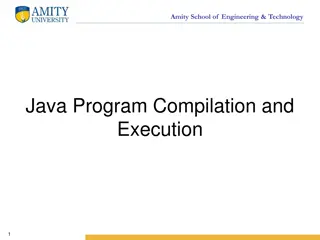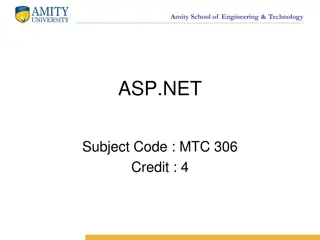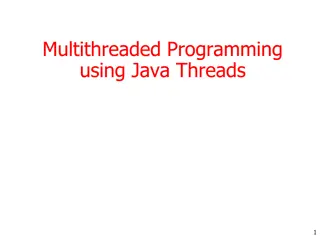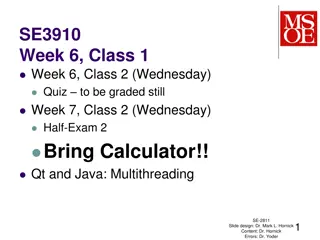Understanding Multithreading and Multiprocessing in Amity School of Engineering & Technology
Explore the concepts of multithreading and multiprocessing at Amity School of Engineering & Technology. Learn about the types of multiprocessing, threads, thread life cycle, advantages of multithreading, and the importance of user and daemon threads in Java programming. Dive into the world of utilizing the CPU efficiently through parallel processing techniques.
Download Presentation

Please find below an Image/Link to download the presentation.
The content on the website is provided AS IS for your information and personal use only. It may not be sold, licensed, or shared on other websites without obtaining consent from the author. Download presentation by click this link. If you encounter any issues during the download, it is possible that the publisher has removed the file from their server.
E N D
Presentation Transcript
Amity School of Engineering & Technology Multithreading 1
Amity School of Engineering & Technology Agenda Multiprocessing Type of Multiprocessing What is Thread Type of Thread Multithreading Thread Life Cycle Multithreading Example Advantages of Multithreading
Amity School of Engineering & Technology What is Multiprocessing The process of using the entire CPU of the computer and being capable to execute more then two processes or computational jobs at a time is defined as multiprocessing.
Amity School of Engineering & Technology Type of Multiprocessing There are two type of Multiprocessing in java. 1) Process-Based Multiprocessing 2) Thread Based Multiprocessing Multiprocessing Process Based Thread Based
Amity School of Engineering & Technology What is Thread(Separate flow of Execution) A thread is an individual, light weight, and a smallest unit of a given process. There are multiple thread in a single process and each thread is independent of the other. As shown in figure ,a thread is executed inside the process .There is a context switching between the threads. There can be multiple processes inside the OS and one process can have multiple threads.
Amity School of Engineering & Technology Type of Thread 1. User Thread 2. Daemon Thread User threads are high-priority threads. The JVM will wait for any user thread to complete its task before terminating it. On the other hand, daemon threads are low- priority threads whose only role is to provide services to user threads
Amity School of Engineering & Technology Use of Daemon Thread Daemon threads are useful for background supporting tasks such as garbage collection, releasing memory of unused objects and removing unwanted entries from the cache. Most of the JVM threads are daemon threads.
Amity School of Engineering & Technology Multithreading Multithreading is a Java feature that allows concurrent execution of two or more parts of a program for maximum utilization of CPU. Each part of such program is called a thread. So, threads are light-weight processes within a process. Threads can be created by using two mechanisms : 1.Extending the Thread class 2.Implementing the Runnable Interface
Amity School of Engineering & Technology Advantages of multithread The users are not blocked because threads are independent, and we can perform multiple operations at times As such the threads are independent, the other threads won t get affected if one thread meets an exception.
Amity School of Engineering & Technology Thread Life Cycle in Java
Amity School of Engineering & Technology New state Before calling the start() method on the newly created thread instance, the thread is in a new state . In this phase, the thread is created using class Thread class . It remains in this state till the program starts the thread. It is also known as born thread.
Amity School of Engineering & Technology Runnable state The thread is in a runnable state after calling the start() method, but it has not been selected as the running thread by the thread scheduler. In this phase, the instance of the thread is invoked with a start method. The thread control is given to scheduler to finish the execution. It depends on the scheduler, whether to run the thread.
Amity School of Engineering & Technology Running state If the thread scheduler has selected it as a running thread, it is on the running state . A thread will only execute its task when it is on the running state .
Amity School of Engineering & Technology Waiting state When a thread is still alive but not eligible to run, then the thread is in the waitingstate . A thread can move from runningstate to waitingstate by certain conditions ex: sleep(), wait(). Same as that a thread can move from waitingstate to runnablestate by certain conditions ex: notify(), interrupt().
Amity School of Engineering & Technology Death state or Terminate When a thread completes all of the tasks assigned to it, or when its run() method exits, it will become a dead thread.
Amity School of Engineering & Technology Example package demotest; public class GuruThread { public static void main(String[] args) { System.out.println("Single Thread"); } }
Amity School of Engineering & Technology Creating Threads We can create threads in two different ways, They are 1.Extend Thread class 2.Implement Runnable interface The behaviour of the thread object will be the same in both ways.
Amity School of Engineering & Technology Method 1-Extend thread class public class Mythread extends Thread{ @Override public void run(){ System.out.println("Hi!! This is from child thread"); } }public class Application { public static void main(String[] args) { Mythread mythread=new Mythread(); mythread.start(); }}
Amity School of Engineering & Technology What is start() method and run() method? We override the run() method and specify the tasks we want to assign to the newly created thread. Then we call the start() method on the thread instance that we created. Please keep in mind that the start() method is belongs to Thread class, and it will call the run() method internally.
Amity School of Engineering & Technology What happens if we didn t override the run() Method? A thread will be created, but it does nothing and then it will go to death state. public class Mythread extends Thread{ //we didn't override run() method here } public class Application { public static void main(String[] args) { Mythread mythread=new Mythread(); mythread.start(); }
Amity School of Engineering & Technology Explanation When we invoke the start() method, A thread will be created. start() method will invoke the run() method internally. Then JVM checks whether the child class contains a run() method. If yes then child class s run method will be executed. If not JVM will execute the parent (Thread) class s run() method. In Java Thread class s run() method doesn t contain any tasks in its body. Therefore if we didn t override the run() method, the Thread class s run() method will be invoked and it does nothing.
Amity School of Engineering & Technology Can we overload the run() method? @Override public void run(){ System.out.println("Hi!! This is from child thread default run method"); } public void run(String name){ System.out.println("Hi!! This is from child thread's over loaded method"); } public class Mythread extends Thread{ } public class Application { public static void main(String[] args) { Mythread mythread=new Mythread(); mythread.start(); }}
Amity School of Engineering & Technology Explanation Yes we can overload the run() method. but start() method will only invoke run() method which has no arguments. Therefore the overloaded run() method will not be invoked by start() method.
Amity School of Engineering & Technology Can we invoke run() method instead of start() method? public class Mythread extends Thread{ @Override public void run(){ System.out.println( This method is executed by: +Thread.currentThread.getName()); } } public class Application { public static void main(String[] args) { Mythread mythread=new Mythread(); //mythread.start(); Mythread.run(); } }
Amity School of Engineering & Technology Explanation We can invoke the run() method directly. but it will not create a new child thread. Instead, parent thread will execute the child thread object s run() method. This will be a typical OOP method invoking.
Amity School of Engineering & Technology Can we override the start() method? @Override public void run(){ System.out.println( This is run method ); } @Override public void start(){ System.out.println( This is start method ); } public class Mythread extends Thread{ } public class Application { public static void main(String[] args) { Mythread mythread=new Mythread(); mythread.start(); } }
Amity School of Engineering & Technology Drawbacks of this way of Thread Creation We know Java doesn t support multiple inheritances. In this way, Since user-created class (Mythread) Inherits the characteristics from Thread class , user-created class (Mythread)can t inherit another class.
Amity School of Engineering & Technology Method 2: Implement the Runnable Interface To create a thread by runnable interface we must create a class that implements runnable interface. public class Rnblthread implements Runnable{ @Override public void run() { System.out.println("Hi!! This is from a child thread which is created by runnable interface"); } }
Amity School of Engineering & Technology Cont.. After implementing the runnable interface we can simply create the thread by creating a thread object. public class Application { public static void main(String[] args) { Runnable r=new Rnblthread(); Thread mythread= new Thread(r); mythread.start(); } }
Amity School of Engineering & Technology Cont.. 1.NEW a newly created thread that has not yet started the execution 2.RUNNABLE either running or ready for execution but it's waiting for resource allocation 3.BLOCKED waiting to acquire a monitor lock to enter or re-enter a synchronized block/method 4.WAITING waiting for some other thread to perform a particular action without any time limit 5.TIMED_WAITING waiting for some other thread to perform a specific action for a specified
Amity School of Engineering & Technology New Runnable runnable = newNewState(); Thread t = newThread(runnable); Log.info(t.getState());
Amity School of Engineering & Technology Runnable When we've created a new thread and called the start() method on that, it's moved from NEW to RUNNABLE state. Threads in this state are either running or ready to run, but they're waiting for resource allocation from the system In a multi-threaded environment, the Thread- Scheduler (which is part of JVM) allocates a fixed amount of time to each thread. So it runs for a particular amount of time, then relinquishes the control to other RUNNABLE threads.
Amity School of Engineering & Technology Example Runnable runnable = newNewState(); Thread t = newThread(runnable); t.start(); Log.info(t.getState());
Amity School of Engineering & Technology Blocked A thread is in the BLOCKED state when it's currently not eligible to run. It enters this state when it is waiting for a monitor lock and is trying to access a section of code that is locked by some other thread.
Amity School of Engineering & Technology Example import java.util.logging.LogManager; Impoort java.util.logging.Logger; publicclassBlockedState { publicstaticvoidmain(String[] args) throws InterruptedException { Thread t1 = newThread(newDemoThreadB()); Thread t2 = newThread(newDemoThreadB()); LogManager lgmngr=LogManager.getLogManager(); Logger log=lgmngr.getLogger(Logger.GLOBAL_LOGGER_NAME); t1.start(); t2.start(); Thread.sleep(1000); log.info(String.valueOf(t2.getState())); System.exit(0); } }
Amity School of Engineering & Technology Example classDemoThreadBimplementsRunnable { @Override publicvoidrun() { commonResource(); } publicstaticsynchronizedvoid commonResource() { while(true) { // Infinite loop to mimic heavy processing // 't1' won't leave this method // when 't2' try to enter this } } }
Amity School of Engineering & Technology Explanation 1.We've created two different threads t1 and t2 2.t1 starts and enters the synchronized commonResource() method; this means that only one thread can access it; all other subsequent threads that try to access this method will be blocked from the further execution until the current one will finish the processing 3.When t1 enters this method, it is kept in an infinite while loop; this is just to imitate heavy processing so that all other threads cannot enter this method 4.Now when we start t2, it tries to enter the commonResource() method, which is already being accessed by t1, thus, t2 will be kept in the BLOCKED state
Amity School of Engineering & Technology List of Commonly Used Thread class Constructors. Thread class has the following eight constructors. Thread(): It creates a Thread object with a default name. Thread(String name): It creates a Thread object with a name that the name argument specifies. Thread (Runnable r): This method constructs Thread with a parameter of the Runnable object that defines the run() method. Thread (Runnable r, String name): This method creates Thread with a name and a Runnable object parameter to set the run() method. Thread(ThreadGroup group, Runnable target): It creates a Thread object with a Runnable object and the group to which it belongs.
Amity School of Engineering & Technology Thread (ThreadGroup group, Runnable target, String name): It creates Thread object with a Runnable object that defines the run() method, specified name as its name and the Thread object belongs to the ThreadGroup referred to by the group. Thread(ThreadGroup group, String name): It creates a thread that has the specified name and associates to the ThreadGroup given as the first parameter. Thread(ThreadGroup group, Runnable target, String name, long stackSize): this constructor specifies the ThreadGroup parameter, the size of the thread s method-call stack.
Amity School of Engineering & Technology Commonly used methods of Thread class 1. public void run(): is used to perform action for a thread. 2. public void start(): starts the execution of the thread.JVM calls the run() method on the thread. 3. public void sleep(long miliseconds): Causes the currently executing thread to sleep (temporarily cease execution) for the specified number of milliseconds. 4. public void join(): waits for a thread to die. 5. public void join(long miliseconds): waits for a thread to die for the specified miliseconds. 6. public int getPriority(): returns the priority of the thread. 7. public int setPriority(int priority): changes the priority of the thread. 8. public String getName(): returns the name of the thread.
Amity School of Engineering & Technology 9. public void setName(String name): changes the name of the thread. 10. public Thread currentThread(): returns the reference of currently executing thread. 11. public int getId(): returns the id of the thread. 12. public Thread.State getState(): returns the state of the thread. 13. public boolean isAlive(): tests if the thread is alive. 14. public void yield(): causes the currently executing thread object to temporarily pause and allow other threads to execute. 15. public void suspend(): thread(depricated). 16. public void resume(): is used to resume the suspended thread(depricated). 17. public void stop(): is used to stop the thread(depricated) is used to suspend the
Amity School of Engineering & Technology 18. public boolean isDaemon(): tests if the thread is a daemon thread. 19. public void setDaemon(boolean b): marks the thread as daemon or user thread. 20. public void interrupt(): interrupts the thread. 21. public boolean isInterrupted(): tests if the thread has been interrupted. 22. public static boolean interrupted(): tests if the current thread has been interrupted.
Amity School of Engineering & Technology Thread Example by implementing Runnable interface class Multi3 implements Runnable{ public void run(){ System.out.println("thread is running..."); } public static void main(String args[]){ Multi3 m1=new Multi3(); Thread t1 =new Thread(m1); // Using the constructor Thread(R unnable r) t1.start(); } }
Amity School of Engineering & Technology Example getName() public class MyThread1 { // Main method public static void main(String argvs[]) { // creating an object of the Thread class using the constructor Thread(String name) Thread t= new Thread("My first thread"); // the start() method moves the thread to the active state t.start(); // getting the thread name by invoking the getName() method String str = t.getName(); System.out.println(str); } }























